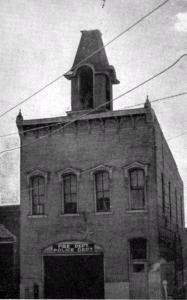
THE OLD CITY HALL – Was formerly located on Chicago Ave behind the current police dept. It was the building that served as the headquarters for the city of Tuscola for 70 years. It was built in 1888 at a cost of $3,500. The fire house and calaboose was located on the ground floor and the council chambers were on the second floor.
The bell that hung in the balcony served as a fire warning for many years. Later, a siren was used. However, the presence of the bell above tended to make the building less safe for use and it was replace with a new building in 1958. The bell has been hung in Ervin Park as a memento of earlier days.
(Originally published August 13, 1959)
The city of Tuscola was laid out in 1857 by officials of the Town Company, who had acquired the site–approximately one section of land–from the Illinois Central Railroad.
The town was plotted to provide 100 feet of right-of-way, east and west, for a proposed railroad. The Illinois Central had been built six years earlier and the prospect for another road added early impetus for the budding growth of the village.
The first house in Tuscola was moved here from Bourbon. It stands on the northwest corner of Daggy and Main Streets. The first building erected was at the railroad, in which Simon G. Bassett lived and served as postmaster, express and freight agent.
The first store was built by B.F. Lewis on the north side of the courthouse. It was later moved to Sale Street.
The city was chartered October 11, 1859. The first officials were James H. Martin, mayor; and E. L. Jordan, E. Price, M. Pugh and W. Taggart, aldermen.
For many years, much area in Tuscola was used as farmland. With the coming in 1952 of the USI and other allied industries, the need for living space had grown and most of the city area has long since been taken up.
Two new subdivisions adjacent to the city have been established. They are Meadowview subdivision and Southland Acres subdivision. Both are south of Route 36, the southern boundary of the city.
Another addition has been annexed to the city on the north. This is known as Parkview addition. Still another subdivision has been started south of Tuscola on land acquired from Lester L. Smith. This is known as Hillcrest subdivision.
The city now has a population of approximately 4,000 people. About 500 additional people live in area adjacent to the city limits.
The present city valuation is $9,050,648.
City officials now have charge of some 120 acres of paved and oiled streets, a 30-acre park with a swimming pool, a 5,000 capacity amphitheatre, baseball diamonds, restrooms, and scores of picnic tables.
The city operates a sanitary disposal plant, with an original cost of $250,000, and is soon to start the construction of a second plant and tributaries, which will cost $500,000.
A fully equipped volunteer fire department, headed by fire chief Douglas “Lucky” Ball, serves the city. Facilities include two fire trucks and a new firehouse, now in progress of construction.
Another city service is that of garbage and trash disposal, with Charles Dowler in charge.
The present city officials are Roy A. Toomey, mayor; O.B. Moorehead, clerk; O.B. Smith, treasurer; A.C. Baer, city attorney; Raymond Owen, police magistrate; R. E. Burns, Don McCumber, Wilbur Hoel, Walter Steiner, John N. Cunningham, Lewis Consoen, and William Alexander, aldermen.
